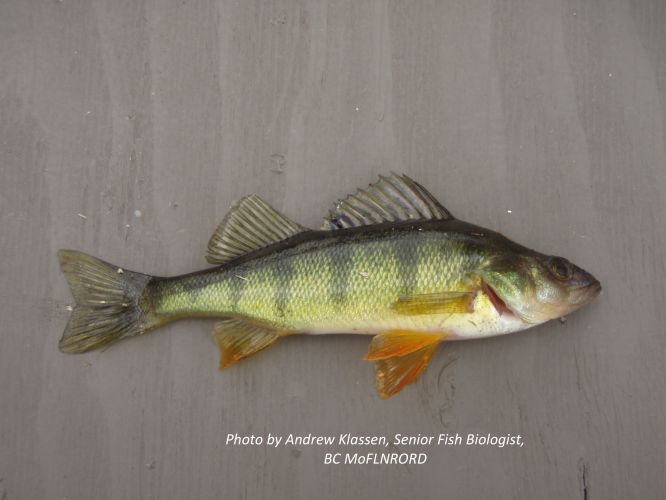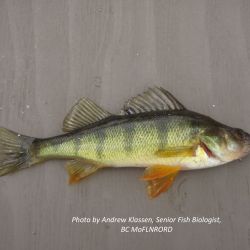
Priority: Prevent
General: Invasive fish to BC but native to many parts of NA. Used to stock lakes for fishing.
Size: 10-25cm long.
Colour: White belly, bright green to olive back and yellow-green sides.
Special Features: They have a yellow-green dorsal (top back) and caudal (tail) fins, yellow-red pelvic fins (bottom belly) and a forked tail. On the sides of their bodies, they have up to 7 green-brown vertical bands.
Walleye (Sander vitreus)
Differences: The Walleye is a larger fish measuring 30-50cm and has canine teeth. Yellow perch do not have canines. The body shape of a Walleye long and slender whereas a perch has an oval, laterally compressed shape.
Where did it come from? Yellow perch are native to Canada and North America, east of the Continental Divide. They can be found from Alberta north into the Northwest Territories and east to Nova Scotia. In the US, they live in North Dakota waters and into the eastern states and south to South Carolina & Georgia.
Where does it live here? Yellow perch are a freshwater fish that live in ponds, creek pools, rivers and brackish waters (slightly salty, mix of river and seawater). They are found in the Kootenays and Okanagan, Vancouver Island and Lower Mainland of Vancouver. They were introduced intentionally for sport fishing.
Reproduction: Females lay up to 15,000 eggs.
When does it reproduce & mature? Spawns in the spring between April & May. The eggs hatch in about 8-10 days. The larva and juveniles that can drift downstream with the current. Females mature after 4 years and males after 3.
Spreads By: Yellow perch have been spread by a variety of ways that all involve humans. They have been stocked as a sport fish, released from fish markets & aquariums and transported unknowingly by boats.
Species Type: Fish
- Voracious feeders that can impact aquatic ecosystems. They can eat young fish & insects.
- Compete with native fish species for food and habitat.
- Carry parasites that harm native fish species.
- Impact salmon growth in BC lakes.
- REPORT all sightings.
- Clean,Drain,Dry your boat, trailer & fishing gear. Dispose of bait in sealed containers.
- Don’t Let it Loose: Don’t let any Yellow perch loose or transfer between lakes in BC. Do not purchase or release aquarium fish into wild lakes, streams etc.
- Contact LRISS for specific information or links to experts.
BC Government. Invasive Species Alert! Yellow Perch (Perca flavescens).
Brown, T.G., Runciman, B., Bradford, M.J., and Pollard, S. 2009. A biological synopsis of yellow perch (Perca flavescens). Can. Manuscr. Rep. Fish. Aquat. Sci. 2883: v + 28 p.
